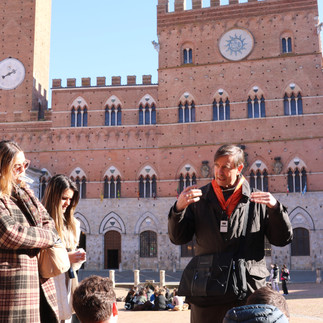Cornell in Rome: A Review
- Desai Wang
- May 22, 2023
- 4 min read
Updated: Sep 19, 2024
On Bus 40 to the train station, I caught glances of places I had visited for class–the corner of Palazzo Venezia, the tip of the obelisk on the Quirinal Hill, Santa Maria degli Angeli and the Baths of Diocletian… It's strange to leave. Today is a Wednesday, I should be in Jeffrey's class and visiting a church, perhaps even two or three. My legs should be aching from Jan’s class on Tuesday, where I always struggle to keep up with his pace while frantically taking notes on ancient structures. I feel like I still have so much to learn–where exactly was the Temple of Jupiter on the Capitoline, what was Bernini's non-ecclesiastical architecture typology, how can we use design to address housing inequity in Rome?
In Ithaca, upper year students made Rome sound like a vacation semester. Chill out, recover from architectural burnout, drink Aperol spritzes starting at noon; Eat pasta, pizza, travel every single weekend. To some degree, Cornell in Rome is an opportunity for all these, but it is by no means wasted time.
Siena with Prof. Jeffrey Blanchard, Hadrian's Villa with Prof. Jan Gadeyne , Aldo Rossi Cemetery in Modena.
Midway through the semester, my friends and I discussed worries about doing too little work. There had been no all-nighters or tears after critiques, and rarely were there any moments of anxiety or feeling overwhelmed. We bathed in the Mediterranean sun, attended class at various sites across the city, and our assignments helped us appreciate Rome’s layered art and architectural histories. In Ithaca, I think there is a strong focus on production. I felt pressured to come up with unique ideas and develop them with rigor. However, Rome for me was never about establishing my own style or leaving a mark. Rather, it was about observing and understanding.
Architectural history classes gradually introduced us to different sections of Rome across time periods. From ancient temples on the Capitoline and Palatine, to medieval fortified ruins in the Field of Mars, to early Christian basilicas on the Aventine, longitudinally planned churches of the Counter Reformation, decadent decorations of the High Baroque… Drawing class brought us to the National Roman Museum at Palazzo Massimo alle Terme, the National Gallery of Modern and Contemporary Art, Accademia di San Luca. We drew inside Termini, at the Nuovo Mercato Esquilino, and even from live models. We talked to Italian artists and saw the work of our professor Luca Padroni at an art gallery opening.
For architecture studio, we studied informal settlements in Rome. Our professors Sean and Alexandre didn’t request us to alleviate the housing crisis, or even to propose architectural programs. Instead, my partner Thuan and I explored 4 Stelle, a squatted property, through narrating an inhabitant’s personal story in drawings. At the final review, it was exciting to see the diverse projects–multi-use modular architecture, play structures for children, community kitchens, a bathroom built for a Roma family… While it was intimidating to have been given full agency over how and what I design, it was also exhilarating to question and explore my interests as a designer.
final reviews and exhibition
At the end-of-semester exhibition, everything in Palazzo Santacroce appeared perfect. Drawings, photographs, collages, models, and planning reports filled our beautiful palazzo-school, and everyone was celebrating in joy. My Ithaca semesters always culminated in stressful reviews and tests, with the last days dedicated to documentation and packing in exhaustion. It was refreshing to end my time in Rome with my peers, professors, past critics, friends of faculty, and I was grateful for their generous compliments. The exhibition proved to me that good architecture does not need to come from painfully laborious work.
Before I went to Rome, I joked that I would either find myself or find God. And in a way, I did both. I am grateful for the reduced academic pressure, which allowed me time to reflect on who I am and what I enjoy doing. I had time to be immersed in the city, to draw it, to write about it, to love it. The “what’s next?” permeating Ithaca campus was swapped for an air of spirituality, and conversations about internships, grad schools and jobs were replaced by lessons on ecclesiastical architecture and development of typologies. Although I don’t believe in god, I leave Rome with infinitely more appreciation for Christian art and architecture, as well as the stories about their creators and patrons.
semester highlights: sunset runs, dinner parties, cheese tasting, classical concert, food with friends...
To me, this city is dinner conversations with roommates over candlelight, Gregorian chants on the Aventine and papal mass in St. Peter’s Square. It is going to Roscoli for maritozzi and Pizza Florida for the carbonara slice and Campagna Amica for fresh produce. It is stone pines in the gardens of Villa Pamphili and sunset runs along the Tiber… Rome is a wonderfully rich book, and I’ve just learned the language with which I can decipher its stories.
Ciao Roma, but hopefully not for long!































The experience of studying abroad in Rome will always be a good memory in your life! Welcome back to the States and we miss you!❤️